Winter/Spring 2022 Rules Archive
Code of Conduct
The mission of The World Axe Throwing League is to promote competition through sportsmanship and fair play. Our Axe Throwing rules assure that all leagues and events are played in a sportsmanship-like manner. Although competition may become intense, we expect our participants to maintain a high degree of sportsmanship up to and after the final throw.
As a participant or spectator at any WATL sanctioned event, you must pledge to:
- Respect the game, play fairly and follow all rules and policies.
- Accept & respect the decisions of WATL officials.
- Demonstrate good sportsmanship before, during, and after games, win or lose.
- Be responsible for the sportsmanship of teammates and assist in maintaining a respectful environment for all participants.
- Be courteous to opposing Throwers, teams, officials, spectators, monitors, or facilitators and treat all Throwers and WATL officials with respect.
- Help to maintain and keep all equipment and conditions at the facility in good condition.
- Obey all facility rules, while respecting all equipment, common areas, playing areas, parking areas, and surrounding neighborhoods.
- Not to engage in discriminatory behaviour based on, but not limited to race, religion, creed, language, gender identity, or sexual identity.
- Refrain from the use of abusive language or profanity. Including but not limited to: contemptuous, discriminatory or denigratory words or actions concerning race, language, religion, gender, or sexual orientation
- Not engage in any behavior which would endanger the health, safety, or well being of any Thrower, official, staff member, or spectator.
- Any verbal or non-verbal intimidation, threats of physical violence, trash talk, abusive language, profanity, threats, or general disrespect during any league or tournament towards any presiding Certified Judge, WATL Official, thrower or spectator will not be tolerated and will result in the immediate removal from the league or tournament.
- Not use alcoholic beverages at any location unless permitted by the facility/venue.
- Not allow, use or encourage illegal drugs at any location.
- Wear/use all required and issued equipment and/or uniforms.
- Under no circumstances are live targets allowed. No thrower is to throw an axe at a target while there is a person or live object in between or in front of the thrower.
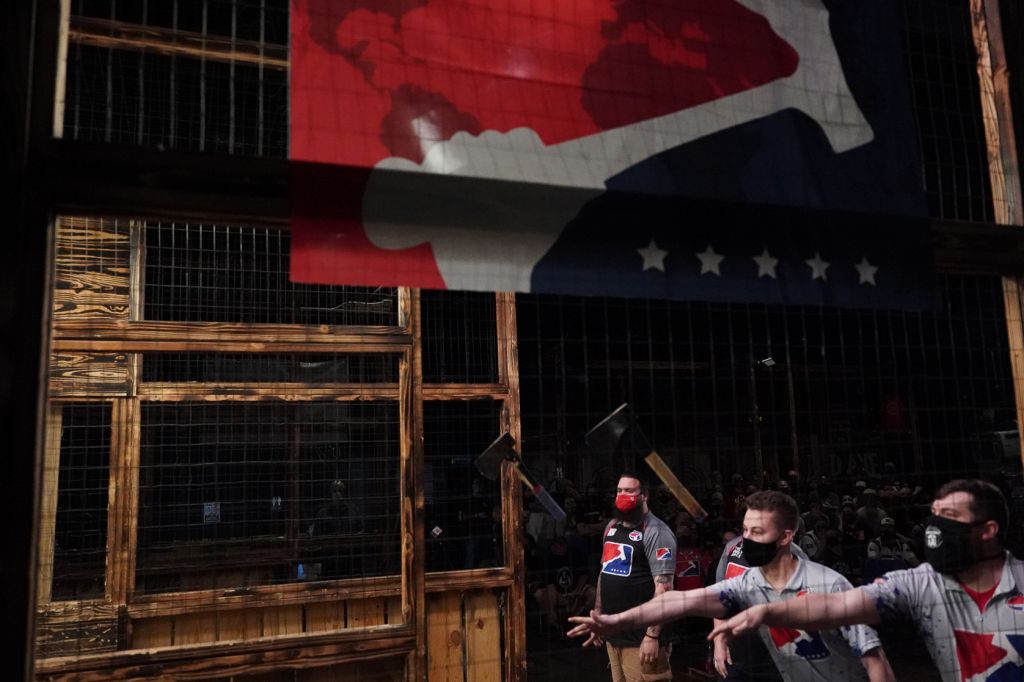
Sportsmanship
Sports are filled with judgment calls and, as a result, disputes may occur. It is important that participants handle all disputes in a constructive manner. WATL has the sole discretion to investigate all evidence available to maintain the integrity of the rules & the sport in any match. Protests for Thrower eligibility or rule misapplications/misinterpretations are time-sensitive and must be made before the next throw. Non-throwers do not have the right to argue or challenge any calls made by a league judge.
All decisions made by on-site WATL Officials must be respected and obeyed. Any feedback regarding rules, Throwers, officials, or staff members should be brought to the attention of WATL via email.
Any behavior deemed unacceptable by WATL officials, Presiding Judges or Affiliate owners may result in a verbal warning, ejection, suspension, and/or expulsion as outlined below. Repeated Code of Conduct violations by the same Thrower or team could result in expulsion from WATL sanctioned events without refunds.
Disciplinary Procedure
All Code of Conduct violations during and outside of matches will result in disciplinary measures.
Upon an offense requiring disciplinary action, it is recommended that the presiding official issue disciplinary action in this order:
- The offending thrower will first receive a verbal warning.
- Should a similar offense occur a second time then their most recent match points will be brought to 0 and the match will count as a loss.
- Upon a third offense by the same Thrower, the offending Thrower will be suspended from the season or tournament.
Pending a formal investigation, WATL reserves the right to suspend the thrower or spectator in question for a minimum of 6 months.
Presiding officials are not required to follow disciplinary measures in this order.
Section A: Gameplay Rules
Safety:
Covid-19 Update
Local guidelines pertaining to Covid-19 must be adhered to at any WATL sanctioned event.
WATL may mandate a mask policy at WATL operated events.
WATL still recommends wearing a mask as a precautionary measure and will be monitoring CDC guidelines for future updates.
- Axes
- Axes may be inspected by an official at any time.
- Axes that do not adhere to WATL specifications, including broken axes, may not be used.
- Participants are instructed to grip the axe by the handle and only the handle.
- If an axe breaks or if a Thrower would like to switch axes, they must notify the presiding official and are allowed up to 1 minute to switch axes.
- Any throwers knowingly throwing restricted axes in WATL Sanctioned events will be subject to a Code of Conduct violation.
- Injuries
- If an injury occurs, resulting in a pause in play, a thrower must be assessed by a judge or onsite medical professional.
- If the thrower is assessed and able to continue, then the paused match may continue.
- If injured during league, a thrower is deemed to be unable to finish the remaining matches, a thrower may make up their matches the following league night with no penalty.
- When a match has not been completed and an injury occurs, the make up match will restart from throw one.
- If an injury occurs in a tournament, and the thrower is deemed unable to compete due to injury, any pending throws will be marked as 0 points and future matches forfeit.
- If an injury occurs, resulting in a pause in play, a thrower must be assessed by a judge or onsite medical professional.
- Throwing
- Axes shall never be thrown when a participant is picking up an axe from the target area or when a judge is in the lane. This will result in an immediate disqualification (counted as a loss) for that match.
- All spectators must be to the side or at least 5ft behind throwers.
Section B:
Pre-Game Rules
1. Minimum Age:
- WATL does not enforce any age requirement or limit. Each affiliated location is allowed to have an age requirement if they so choose. Please contact your local participating league location to inquire about their age rules.
- Throwers under the age of 18 may name a representative to act on their behalf. The representative is only able to challenge calls on behalf of the Thrower. Each representative is to be named before the start of the sanctioned event. The representative is expected to follow all rules of play as if they were the competitor.
2. Target Quality:
- Targets should be of sound quality before gameplay starts.
- Boards all must be individually secured and not able to slide or lift off from the target during sanctioned events.
- Before the start of a match, target boards should be switched out (at the judges discretion with or without a throwers request) if the boards have deteriorated to a point where:
- excessive movement or ‘wiggling’ of the axes occur when they land in the damaged area causing or risking good throws to fall out
- lines of scoring areas are missing significant gaps
- the integrity of the target rings is misshapen to the point that the target rings are greater than ⅛ inch larger or smaller than the original target.
- If boards have deteriorated during a match, a thrower may request an evaluation by the Judge.
- Should the boards be evaluated as excessively deteriorated at any time during a match a Judge may opt to change lanes, if a lane is not available – a change of target boards may occur.
- If a lane or board is changed, Throwers will not be granted a practice throw.
- No one other than the presiding match judge may alter the boards before, during, or after any match unless authorized by that individual. This includes, but is not limited to pulling out pieces of boards, and chopping or softening the board with their axe.
- Watering a board is not considered an alteration.
- Boards may only be watered by a Thrower before to the start of the match.
- Violation of this rule by a thrower results in a 0 for their next throw. If this occurs during or after the last throw of a match, the action will be considered a violation of the Code of Conduct.
- Violation of this rule by anyone other than a thrower will be considered a violation of the Code of Conduct.
- Watering a board is not considered an alteration.
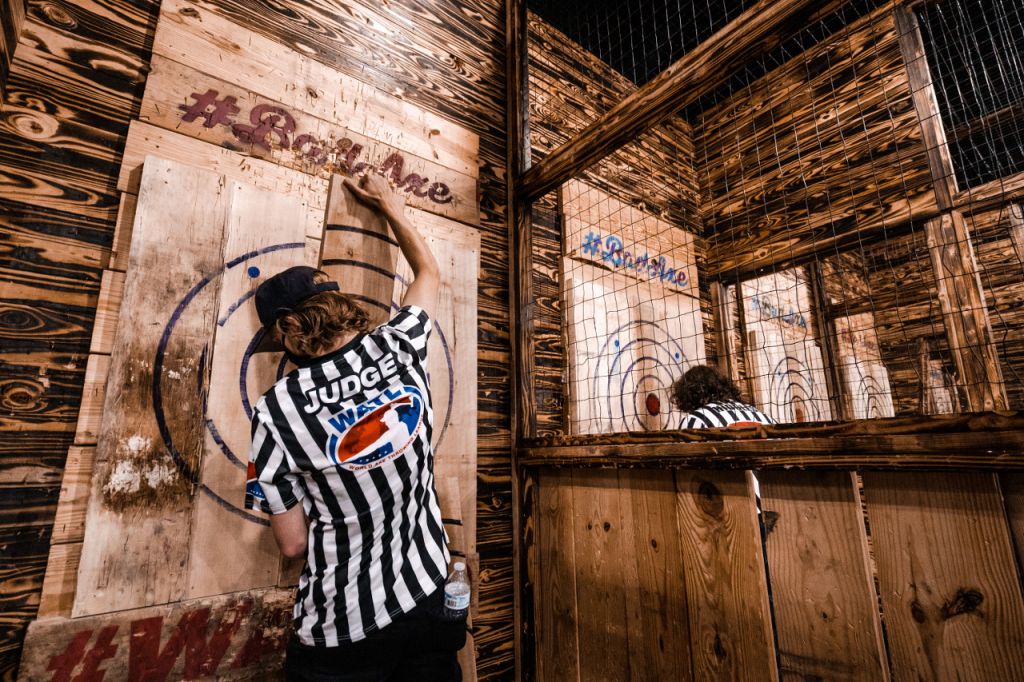
3. Warm Up Throws:
- The number of warm-up throws allowed applies to all WATL sanctioned leagues and tournaments.
- Players may have up to 5 practice throws before their first game
- Players may have 1 practice throw before any subsequent games
- Players may have 1 practice throw between games in the case of a best 2/3 match set
- Throwers are not allowed additional practice in empty lanes between matches for any sanctioned tournaments unless otherwise approved by a Tournament Host or presiding WATL Judge, and made available to all throwers.
- During Leagues, practice or warm-up areas may be offered at the discretion of the venue so long as best efforts are made to make it available equally to all throwers.
- League may allow practice throws before official league start time subject to availability, fairness, and consent of judge(s) on-premises.
- A presiding official may, at their sole discretion, determine a different amount of warm-up throws during any sanctioned WATL event
- The presiding official will notify players when their match will commence.
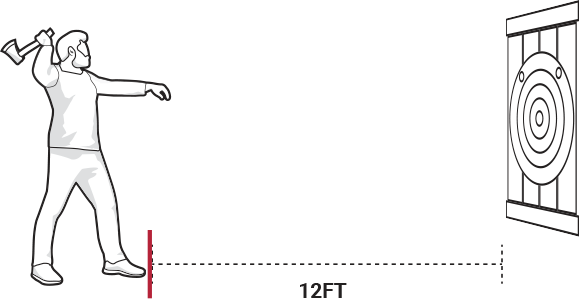
Section C:
Gameplay
- Each match is played against different opponents, opponents must be selected at random via matchmaking in the app and consists of the following:
- Each game consists of 10 throws.
- In each game, players will take 5 throws and then switch sides.
- This ensures fair play when there are varying densities in wood.
- If there is a tie after 10 throws, there will be sudden death:
- See Section D, xvi
- Each league week allows every participant 4 matches.
- Starting targets will be determined by the random selection initially made by the app.
- WATL players are allowed to throw axes in one of two ways:
- 1 hand holding the axe, in an overhand or underhand position, with the blade facing the target before release.
- 2 hands holding the axe with the blade facing the target before release.
- No other style of throw is permitted.
- Rotation: the axe must make approximately 1 rotation for the throw to count.
- If the axe is close to making a full rotation (ie. 50% rotation) and a portion of the blade touches and sticks to the target, the throw counts.
- One foot must be on the floor while the axe is thrown.
- A fault occurs when any of the following conditions are met, before both players scores are verbally expressed by the judge:
- a throwers foot crosses the 12ft fault line
- any other part of the thrower’s body touches any part of the lane, equipment, or building, past the 12ft fault line and towards the target.
- No throw will be taken without a verbal or gesture signal of an Open Lane from the presiding judge and confirmed by all throwers.
- If no signal is given or confirmation received, and a throw is made by a thrower, then that throw will count as a fault.
- Throws must be taken within 10 seconds of each other.
- If a thrower throws after 10 seconds of the other throwers axe coming to rest, this will result in a fault.
- In the case of a fault occurring, the throw will be marked as a fault in the app, resulting in a score of 0 for that throw.
- If a player calls for a second opinion, both players must return behind the 12ft line until the second judge calls the score.
- If a player touches their axe before a second opinion call is made, the original score given by the first judge stands.
- Throwers are limited to 8 single thrower matches each league season.
- If it is necessary to play more than 8 single player matches per season due to extenuating circumstances, WATL must be contacted in writing via email for approval.
- If a Thrower records more than 8 single Thrower matches in a single season, without the prior approval of WATL, all single matches after the 8th will be scored an automatic 0.
- Manual Matchmaking:
- Any individual found manually creating matches that WATL deems excessive (i.e. playing against the same person more than could be accounted for by the random matchmaking in the WATL app) may be subject to disqualification of their scores in league, and nullification of any circuit points gained from that league.
- All scores must be uploaded into the WATL App in real time and uploaded to the leaderboard.
- If connectivity issues occur, all scores must be uploaded to the WATL App within 48 hours.
- If connectivity issues happen for more than 2 weeks in a given season, the venue must contact WATL for guidance.
- After 7 weeks, the 8th and final week of each season will be the playoffs to determine the season’s Local Champion.
- See Section L, i
- Each official league run by an axe throwing venue is self-contained and may not be combined with other leagues.
- Players may only compete at the venue and league they are registered for. There will be no scores recorded outside of that league or venue for their single registered league.
- For example, a player may not compete in week 2 of league at venue A, then compete in week 3 for that same league in venue B.
- Players may only compete at the venue and league they are registered for. There will be no scores recorded outside of that league or venue for their single registered league.
- No item or equipment used to impede or block external sounds may be utilized while throwing.
- Pauses in play
- A presiding official may call a pause in play for any reason deemed necessary (rules review, confirmation, second opinion, etc…)
- Should a pause in play occur, all gameplay must cease immediately and will resume at the discretion of the presiding official, where the pause began.
- For Example: If one player has thrown but the opposite player has not and there is a pause in play called, the game will resume with the opposite player throwing as normal.
- Players may challenge a call or ruling which will create a pause in play
- During this call, gameplay will be paused at that moment in time
- Throwing in a wheelchair
- For individuals who use wheelchairs, all standard league rules apply except the foot fault line.
- Individuals in wheelchairs must have one wheel behind the fault line when throwing in competition play.
- Any wheel on the wheelchair is acceptable as long as one of them is behind the fault line
- For individuals who use wheelchairs, all standard league rules apply except the foot fault line.

Section D:
Scoring
- Scoring Area of Axe
- The axe head, blade and cheek up to the front of the eye but not past it.
- An axe’s score is determined as the axe rests in the target and should not be removed to determine the score.
- Please see the exception for Duals throwing in Section N, vii
- If there is no visible eye of the axe in the top of the axe head then it counts as where the handle would meet if going straight through. To be determined by the official presiding over the match.
- A break (breaking) is defined as when the scoring area of an axe is embedded in the wood and the marked surface of the target area is visible on both sides.
- For example: Touching the black line of the 5 ring is scored as a 4. Breaking the 5 ring (unmarked wood of the outer bullseye on both sides) counts as a five.
- If the axe breaks multiple sections of the target simultaneously, then the player is awarded the points for the higher valued section.
- Killshots must have a red outline using a ballpoint pen which will count as a scoring area, but any blue that bleeds outside of the red outline will not.
- The outline surrounding Killshots and Bullseyes is a valid scoring area.
- The inner bullseye must have a black outline using a ballpoint pen which will count as a scoring area, but any red that bleeds outside of the black outline will not. To gain points for the inner bullseye, the axe must break red or black if inside of the black outline.
- Points
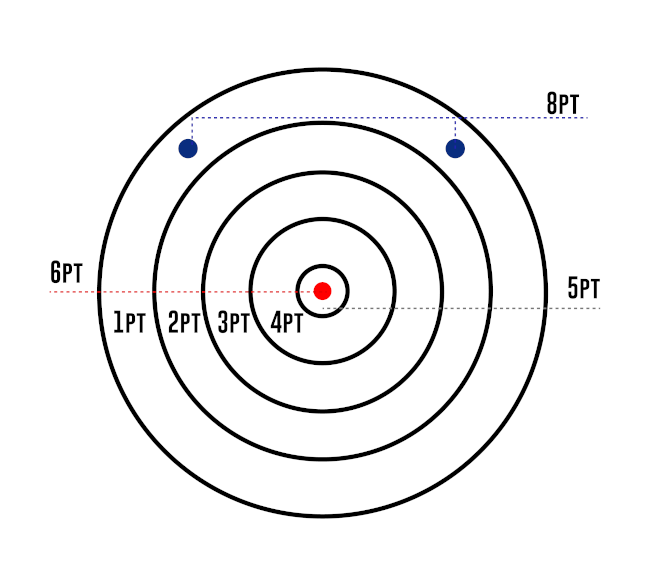
- 1 point for the outermost ring
- 2 points for the 2nd outermost ring
- 3 points for the 3rd outermost ring
- 4 points for the 4th outermost ring
- 5 points for the 5th outermost ring
- 6 points for the bullseye
- 8 points for the Killshots when activated and hit.
- If the axe falls before the presiding official scores the axe, the axe is counted as a drop
- Killshot Throw
- The Killshots are active for any throw during the 10 throw, Standard Hatchet game.
- Before throwing for the Killshot, the player must make clear to the Judge and their opponent that they intend on throwing for the Killshot.
- The call must be made to the Judge before either opponent throws.
- This is referred to as “calling the Killshot” and activates it for the full 8 points.
- The player cannot change their call once a Judge confirms the intent to throw a Killshot.
- Before throwing for the Killshot, the player must make clear to the Judge and their opponent that they intend on throwing for the Killshot.
- The Killshots are active for any throw during the 10 throw, Standard Hatchet game.
- During a game, both throwers may independently call up to 2 Killshots at any time.
- Once a thrower hits a Killshot during the game, that Killshot cannot be attempted again until the opposite killshot is hit. A hit Killshot(s) does not reset until;
- the opposite Killshot is hit
- or the game enters into sudden death (OT)
- or the game is completed
- Once a thrower hits a Killshot during the game, that Killshot cannot be attempted again until the opposite killshot is hit. A hit Killshot(s) does not reset until;
- A judge should remind throwers on which Killshot they threw on if the Killshot is hit during previous attempt(s), so the throwers know which Killshot is open
- It is also recommended that players confirm with the Judge, which Killshot is open for subsequent throws when a previous Killshot is hit
- If a Killshot is attempted but missed, the thrower may throw for that Killshot again.
- In the event of a drop during any throw (except the tenth), the thrower who dropped may opt to attempt one additional Killshot
- A drop must be correctly recorded in the app allow a 3rd Killshot attempt.
- Example: If a player has taken their 2 Killshot attempts and a drop occurs on the 7th throw, they are eligible for a third Killshot attempt on the 8th throw.
- A drop must be correctly recorded in the app allow a 3rd Killshot attempt.
- If a stalemate is caused by both throwers refusing to call a Killshot, or initiate a throw, the Judge will make a verbal announcement that each thrower has 10 seconds to declare their intent to go for Killshot after which time the ability to call kill will no longer be available.
- If the player does not indicate that they are making a Killshot attempt, the Judge will assume it will be a standard throw (a non-Killshot attempt)
- If the Killshot is called, but the player’s axe does not hit the Killshot, then no points are awarded.
- Sudden Death
- In the event of a tie after 10 throws in a single game, the game enters sudden death.
- Points are not counted or tallied during sudden death.
- ONLY Killshots are active during sudden death throws.
- Players will remain at their respective targets for sudden death throws (no switching of targets required).
- If all players hit the Killshot, an additional sudden death throw is required and players must throw again for the alternate Killshot.
- Throwers will remain in their respective targets for sudden death throws.
- If both players miss the Killshot during Sudden Death, a measuring tape or accurate measuring device, will be used to measure the distance from the closest valid scoring area of the axe head to the closest edge of the Killshot.
- If measurements are inconclusive, resulting in a tie, players must throw again for the alternate Killshot.
- The player with the shortest distance will be awarded the game.
- If Player 1 has an axe that has dropped and Player 2 misses the Killshot, but is on the board, Player 2 will be awarded the game.
- If a player touches their axe before a measurement is made, the game is awarded to the opposing player.
Section E:
Attendance
Late Players and/or Early Departures
- Venues will provide a minimum 15 minute grace period for players to arrive, after the official league start time.
- If a thrower arrives later then the time allowed as established by the venue, each game that they miss will be awarded to their opponent, and the opponent will still throw the match for a score. The missing thrower will receive a 0 for each throw in the match(s).
- If a thrower leaves before all their league night matches are completed, it is at the venues discretion to:
- allow the player to make up the game the next league night they are in attendance
- award their opponent the win, and the thrower that left receives a 0 for each throw. The opponent will still throw the match for a score.
Tournament/Playoff Exception
- Players are required to arrive at the playoffs at the start of regulation play.
- If a player is not present when their match begins, a 10 minute grace period will be offered.
- If the player does not show up, they will forfeit their match and the player that is present will be awarded the win.
- If the player arrives during their grace period, but is late for their next match, they will be immediately disqualified.
Absences
- Throwers are allowed to make up any amount of missed matches during regular league nights, but all matches must be made up by week 7. Matches that are not completed at the end of week 7 will not be recorded as played.
- Any matches that are pre-thrown, or made up, MUST be completed during the regular league night. Matches CAN NOT be pre-thrown, or made up, outside of the regular league day/time.
- All matches that are made up, or pre-thrown will be subject to the single thrower and manual matching rules defined herein.
Section F:
Misconduct
- Purposeful Distractions are defined as, but not limited to: Excessive celebration, taunting, using abusive, threatening or insulting language, trash-talking, stepping in the lane during a throw, excessive noises, offensive gestures to opponents or any purposeful distractions with the intent to distract a player during a league match or tournament round will not be permitted during games.
- First Offense:
- The first purposeful distraction from an opposing player will result in a zero score for that throw, for the player causing the distraction
- The first purposeful distraction from a spectating league member or tournament participant will result in a zero in their first throw of their next match
- The first purposeful distraction from a spectator not participating in the sanctioned event, will result in the immediate removal from the facility
- If the first purposeful distraction is a gross violation, intended to either save the player from a loss, intimidate the opposing player, or be an act of aggression against the opposing player or Judge, WATL or the presiding Judge may elect, at their sole discretion, that the player causing the purposeful distraction to be removed from the tournament, league and/or facility.
- Second Offense:
- The second purposeful distraction from an opposing player will result in a forfeit for that match. Zero scores will be entered for the full match.
- The second purposeful distraction from a spectating league member or tournament participant will result in a forfeit from their subsequent match. Zero scores will be entered for the full match.
- Third Offense:
- The third purposeful distraction from an opposing player will result in a forfeit of the season for league play or forfeit from the tournament. The player will not be allowed to throw for the remainder of the season or remainder of the tournament.
- The third purposeful distraction from a spectating league member will result in a forfeit of the season or tournament. The league member or tournament participant will not be allowed to spectate or participate for the remainder of the season or tournament.
- First Offense:
- Match Fixing & Sandbagging in League Play or Tournaments:
- If any player is found to fix a match to achieve a desired outcome, during league play or tournaments, then that player will be banned from all WATL tournaments & leagues. Players may appeal the ban, one year after the offense, pending review of the Commissioner.
Procedures and Specifications
Section G:
Lanes
- Each throwing area is designated as a throwing lane.
- A regulation lane for competition must contain 2 targets.
- Fences or walls block this area from the rest of the facility to keep throwers and axes all contained in a safe environment.
- Only the two participating throwers and the axe throwing judge are allowed inside the lane at one time. This includes ensuring the area behind the throwers is clear of any other person up to 5′.
- 10 ft minimum/clear ceiling height (within the throwing lane) is recommended for safety reasons.
- It is recommended for a lane to be a minimum of 12ft in width with the targets evenly distributed.
- It is recommended for a lane to be a minimum of 15ft in length to accommodate for a 12ft fault line and safe space to throw.
- For venues wishing to host Big Axe throwing, it is recommended for a lane to be a minimum of 20ft in length to accommodate for a 15ft fault line and safe space to throw.
- It is recommended that fault lines be 3 inches wide and that the fault be measured from the front of the target to the back of the line; if throwers step into/past the line, it is a fault.
Section H:
Targets
Building A WATL Target:
- Each Target should be made of 3 layers of wood.
- The first layer should cover the wall in OSB or plywood.
- The second layer is called the Backboards and should be made of wood.
- There should be horizontal 2x10s, that are 4′ feet long, drilled into the wall and packed tightly together to cover the full space for the outer Targets. (This usually takes 6 – 8 boards) This will be the backboard where you will then drill your target boards against.
- The third and outermost layer is called the Target boards. These are also made of 4′ feet long 2×10 lumber. The targets consist of two components: 1) the targets 2) the headers and footers.
- End Grain wood is permitted for WATL targets
- Approximate Measurements for the 2×10 boards:
- U.S: Thickness:1-1/2 in • Width 9-1/4 in • Length 4 ft.
- Metric: Thickness 38mm • Width 235 mm Length 1.22m
- A variance of these measurements is allowed. WATL does not enforce the exact thickness or width of boards, rather, the proper and accurate size of target specifications.
- They should be arranged just like the example picture below.
Headers and Footers:
- Above and below the targets, you will install headers and footers. This will help protect the top and bottom areas of the target while allowing for the branding of your company.
- Header: drill one 4′ foot long 2×10 piece of wood horizontally on top of the target against the backboard.
- Footer: drill one 4′ foot long 2×10 piece of wood horizontally on the bottom of the target against the backboard.
- The footer also provides the benefit of allowing you to change boards quicker and easier.
- The top of the footer should be 36 inches off the ground.
- The end product is a backboard that is 4′ feet x 6′ and another layer of wood that fully covers the back at 4′ feet x 6′ as well.
WATL Target Design
- Each WATL affiliated location shall purchase an official target protractor/stencil.
- The small hole on the left of the stencil will have a screw that will be drilled through it into the center of the middle board. (Approximately 24 inches in the center of the board. That will make 60 inches from the floor).
- A black, 20mm marker will then be used to draw the remaining circles.
- Holes are 22mm thick to allow for a marker to fit that has 1/2″ thick felt.
- Lines are to be 20mm thick.
- The bullseye is 1.5” in diameter, outlined with a black waterproof pen, and colored in red.
- The bullseye must be 24” inches (60.96 cm) from the bottom of the board. This should make the center of the bullseye 60″ from the floor.
- The Killshot (2 blue circles) are 1.5” inches in diameter and positioned inside the 1 point ring.
- The bottom of the Killshot is positioned approximately 35.25 inches from the bottom of the board to the bottom of the Killshot and 2.5 inches from the outer side of the board ensuring they are centered inside the 1 point outer ring. This should make the bottom of the Killshot 71.25″ from the floor.
- The Killshot should be 1.5” in diameter, outlined with a red, waterproof ballpoint pen that clearly denotes the Killshot, thereby eliminating overspray or bleeding caused by markers. The red outline of the ballpoint pen will count as a scoring area, but any blue that bleeds outside of the red outline will not.
- All targets must be level (no slanting of the targets are allowed).
- Targets will have no marking other than the lines, bullseye, and Killshots
- “#WATL” or “World Axe throwing League” is required to be listed prominently on either the header or footer boards
- WATL requires proper lighting insofar as boards can be seen clearly from behind the throwers.
- Projected Targets are not WATL compliant. Only boards with physical markings are permitted.

Section I:
Hatchet Regulations
- The blade (or bit) of the axe can not be longer than 4 inches.
- This is to be measured from tip to tip in a straight line.
- No second bits or spikes on the opposite side of the axe head from the forward facing bit of the axe.
- Decorative blunt objects are allowed but there may not be anything that could be considered sharp. This will be determined by the presiding match official.
- Handle Max Length can be no more than 19in/48.26cm as measured from the lowest point of the handle to the highest point of the eye on the top of the axe head.
- Handles may be made from any material
- Maximum Weights of an axe
- Axe Total = 3 lbs/1.36 kg
- Broken axe
- If the judge determines that a throwers axe has broken during a game. The thrower must provide a replacement axe to be verified and approved by the judge. If they do not provide a second non-broken axe within 1 minute they will have the rest of their match throws counted as 0.
- The thrower is allowed 1 practice throw with the new axe before continuing the game.
- If the judge determines that a throwers axe has broken during a game. The thrower must provide a replacement axe to be verified and approved by the judge. If they do not provide a second non-broken axe within 1 minute they will have the rest of their match throws counted as 0.
- Axe Heads must be one solid piece of metal held tightly to the handle.
- Axe Heads that have become loose are dangerous and will not be considered for league play.
- Axes Heads that have become loose or have an axe head that is easily removed (ie. heads that are clamped or held into the handle by screw or pin) are not legal for sanctioned events, unless otherwise approved by WATL.
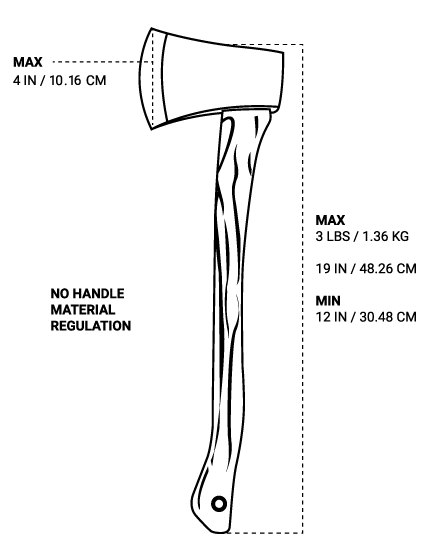
Section J:
Judges
- A Certified Judge must always be present while members are throwing during league play.
- A 5′ radius should be maintained around every participant holding an axe, however, the judge may approach the participants and enter this 5′ radius to provide instruction.
- After a call is made by the lane judge, the Lane Judge or throwers may request a second opinion from the residing Head Judge or, if a Head Judge is unavailable, another Certified Judge.
- The second opinion is the final call and can not be disputed further.
- If the axe in question is touched by any thrower before the decision is made, the thrower who touched the axe will receive a 0 for that throw.
- While a second opinion is being discussed, throwers must return behind the fault line.
- Judges will not be, or become, under the influence of any alcohol or substance during any time they may reasonably be expected to judge matches. If it is suspected that a judge is under the influence, then they must be removed from judging immediately and may be subject to removal of their certification.
- Certified Judges:
- At least 1 Certified Judge per 16 throwers is required to be present for WATL Leagues or Tier 5 Tournaments
- At least 3 Certified Judges are required to be present for Tier 3/4 Tournaments
- At least 2 Certified Judges are required to be present for Tier 2 tournaments
- There must be at least 1 Certified Judge for every lane scored for Tier 1 Tournaments, including the World Championship
- Certified Judges are allowed to participate as throwers but may never score their own matches.
- Judges may not preside over matches where there is a conflict of interest. This would include judging: family members, duals partners, significant others etc)
- Judges are responsible for disclosing any conflicts of interest to players before a match
- We encourage the Head Judge to note and avoid potential conflicts
- Players can request another Judge if a conflict of interest is present.
- Judges are responsible for disclosing any conflicts of interest to players before a match
- Judges will not take advice, second opinions, or consultation from any throwers or spectators.
- Any throwers found to be persuading or advising an official judge will receive a Code of Conduct violation.
- If another judge or thrower believes that a judge is not following current rules and regulations or is making incorrect calls, they must report it directly to a Head Judge or persons in charge of running the tournament immediately.
- Any gross misconduct from Certified Judges may be reported to [email protected]

Section K:
Regular Season
| League | Start | End |
| Winter | January 1, 2022 | February 27, 2022 |
| Spring | March 19, 2022 | May 15, 2022 |
| Summer | June 04, 2022 | July 31, 2022 |
| Fall | August 20, 2022 | October 16, 2022 |
| Venue Cup | November 6, 2022 | December 3, 2022 |
- The entire season lasts 8 weeks including playoffs.
- The first 7 weeks are match play where players contribute towards their seasonal score.
- Week 8 is reserved for the league playoffs.
- See Section L
- Sanctioned League
- A Sanctioned League is the axe throwing league hosted at a participating WATL affiliated venue that follows the rules and regulations of the World Axe Throwing League.
- WATL Sanctioned Leagues must have a minimum number of throwers:
- Standard Hatchet: 6 Throwers
- Big Axe: 4 Throwers
- Duals: Two Teams (4 Throwers)
- Throwers are required to complete at least twelve games to be counted toward league minimums.
- If Sanctioned League requirements are not met, the league will be considered a recreational league and will not be eligible for Circuit Points.
- WATL must be notified at least 2 weeks in advance, before the end of the season, of delays to the end of a season due to acts beyond the reasonable control of the venue.
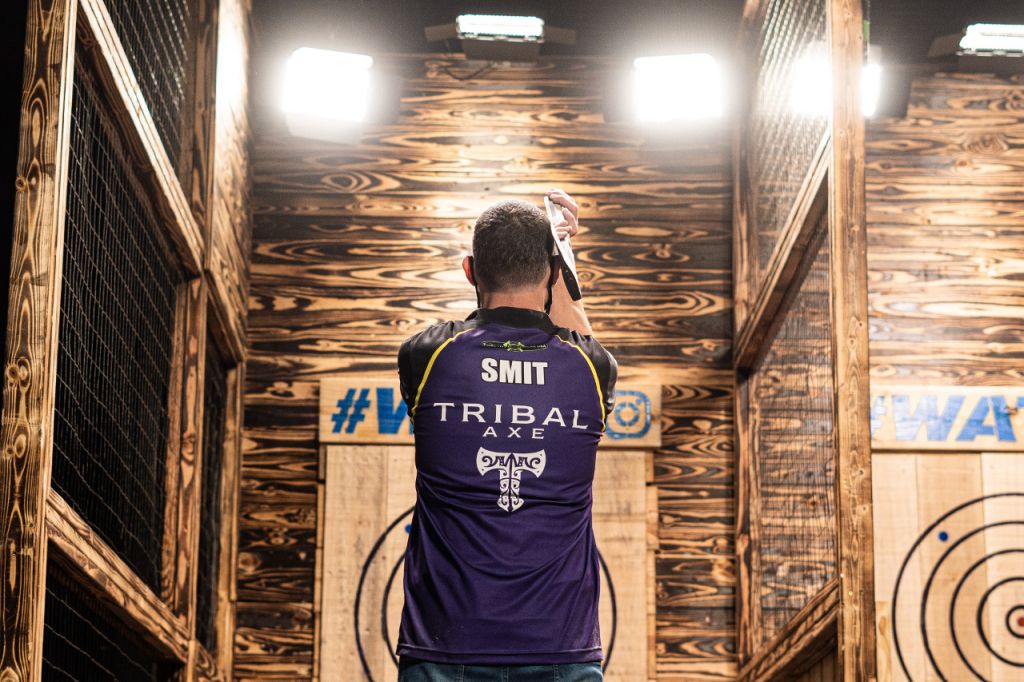
Multiple Sanctioned Leagues
- A WATL affiliated venue may host more than one sanctioned league per season.
- Each additional league a venue hosts must meet the minimum requirements for throwers, not counting throwers that are participating in another league at the same location (not including Marathon League Throwers).
- Throwers already participating in another sanctioned league at the same venue do not count towards the minimums.
- Marathon leagues are excepted from this rule, and throwers participating in marathon leagues may also count towards a regular league minimum
- Throwers already participating in another sanctioned league at the same venue do not count towards the minimums.
- Each additional league must include:
- Standard Hatchet: 6 Throwers
- Big Axe: 4 Throwers
- Duals: Two Teams (4 Throwers)
- Each additional league a venue hosts must meet the minimum requirements for throwers, not counting throwers that are participating in another league at the same location (not including Marathon League Throwers).
- Throwers may participate in as many sanctioned leagues as they wish, but only one league per season will be considered for circuit points.
- Throwers participating in multiple sanctioned leagues must use the same profile and Player ID to compete in all leagues.
- WATL is not responsible for Circuit Point issues from using multiple Player IDs
- Circuit Points will automatically be assigned to the single league that gives the player the most Circuit Points.
Marathon Leagues
- Marathon Leagues may be held anytime during a WATL League Season
- Venues may host a maximum of two Marathon Leagues per discipline in any given season.
- A Marathon League is officially sanctioned as long as it meets the following requirement:
- A Marathon League is a league that is held, in its entirety, within 24 hours.
- Meets the minimum thrower requirements as outlined in Section K, iv, b.
- Players may compete in multiple sanctioned marathon leagues in the same season.
- All rules about regular season play, playoffs, circuit points, and qualifying apply.
Section L:
Playoffs
- During the League Playoff (Week 8) tournament all league members will have the opportunity to participate in a double elimination bracket.
- Each bracket matchup is called a round.
- Venues can choose if Week 8 rounds consist of a single match or a best 2/3 match format for their Week 8 tournament.
- Regardless of the tournament format choice, the final Championship round consists of the best of 2/3 matches.
- See L, iv for more details
- Seeding is done using the total match wins from weeks 1 through 7.
- In the case of a tie for match wins the seeding will be based on the total points gained during weeks 1-7 between the two tied players.
- All competitors eligible for playoffs will be put into two sets of brackets, the winner’s bracket and underdog bracket (A and B brackets for short) after the first round. The first-round winners proceed into the A bracket and the losers proceed into the B bracket. The A bracket is conducted in the same manner as a single-elimination tournament, except that the losers of each round “drop down” into the B bracket.
- The final Championship round is between the winner of the A bracket and the winner of a B bracket consisting of the best of 3 match. Allowing for one practice throw between each game.
- The winner: will be the person who wins 2 out of the 3 games first.
- The A winner must lose twice for the B winner to win the Championship.
- This means that if the B winner beats the A winner in a best of 3 matches, they must play another best of 3 match for the B winner to win the Championship.
- The A winner must lose twice for the B winner to win the Championship.
- The winner: will be the person who wins 2 out of the 3 games first.
- For WATL sanctioned tournaments, bracket tie breakers will be determined by the average bullseye hit percentage in the tournament.
- For example, in a tournament, if players A & B are tied in 5th and 6th place, the Player with the highest average bullseye percentage hit will be in 5th place and the subsequent player will be in 6th place.
- Duals bracket tiebreakers will be based on the total Duals team average bullseye hit percentage. Not the individual players in a team.
The World Championship
The World Axe Throwing Championship is held once per year after the end of the Fall season.
Section M:
Qualifying for the World Axe Throwing Championship
Circuit Point Distribution
- Circuit Points: Points awarded for placements in WATL Sanctioned Events including tournaments and leagues. Points vary based on placing and event.
- Circuit points will be allotted to individual WATL App accounts, it is the responsibility of the thrower to ensure they are using only a single account across tournaments and venues
- Each season there is not a limit to the number of leagues that a thrower can compete in.
- Circuit Points will automatically be assigned to the single league per season that gives a Thrower the most Circuit Points.
- Seasonal Circuit Points are cumulative throughout the entire year. Each season Throwers earn points according to their total score in the qualifying league.
- Tournament Circuit Points will automatically be assigned based on a throwers best finish in each tournament tier. There is no limit to the number of tournaments a thrower can attend in each tier through the year.
- Example: Player A attends two Tier 4 Tournaments in the year. They place 3rd in the first Tier 4 Tournament. In their next Tier 4 tournament, they place second.
Player A will receive the Circuit points for their for their highest finish (2nd Place) in the Tier 4 Tournament.
The same thrower attends three Tier 3 tournaments, and finishes 5th, 8th, and 17th. In addition to their Tier 4 circuit points, that thrower will receive Tier 3 points for their best finish in this tier (5nd).
- Example: Player A attends two Tier 4 Tournaments in the year. They place 3rd in the first Tier 4 Tournament. In their next Tier 4 tournament, they place second.
- For clarification, players are encouraged to participate in every tier. The highest placement will be taken from each tier for the purpose of awarding circuit points.
- Circuit Points are reset to 0 at the end of the WATL year.
A full breakdown of Circuit Point Availability can be found here:
- Tie Breakers: If there is a Circuit Point tie, the winner will be decided:
- By a throwers highest finishing place on the WATL Leaderboard in all calendar seasons
- If there is still a tie, by a throwers season score in their most recent season
- If there is still a tie, by a throwers number of bulls hit in their most recent season
- If there is still a tie, by a throwers number of hit kill shots in their most recent season
- Qualifiers:
- Players with 1 or more Circuit Point(s) may throw in Qualifying Throws
- Qualifying Throws take place in-person at a WATL venue to qualify players for WATC
- 2022 WATC Qualifiers will run from 12:01 AM EST August 20th, 2022 – 11:59 PM EST September 25th, 2022
- Hatchet Qualifiers will consist of 50 throws
- Mandatory Killshot on every 5th and 10th throw
- Standard league play of open Killshots does not apply, Killshots do not have to be alternated
- 10 overtime Killshot throws (used as tie-breakers)
- Killshots do not have to be alternated
- Mandatory Killshot on every 5th and 10th throw
- Duals Qualifiers will consist of 25 throws per team
- Mandatory Killshots on every 5th throws for both throwers
- 5 overtime Killshot throws for each thrower (used as tie-breakers)
- Big Axe Qualifiers will consist of 25 throws
- Mandatory Killshots on every 5th throw
- Additional 5 overtime Killshot throws (used as tie-breakers)
- Venues set a time to hold their Qualifiers before the stated deadline
- Local venues must have at least one WATL Certified Judge on-premise to judge throws and collect scores
- Any thrower found to be scoring themselves will be disqualified.
- For Throwers that do not have a WATL venue readily accessible, or are not within a 2 hour travel distance between your primary residence and your closest participating WATL venue, please contact WATL via email for information on Qualifiers.
- Regional Tournament:
- By July 31st, WATL will provide an update regarding Regional Tournaments.
- Each region will host a tournament consisting of ALL 3 disciplines, between the dates of October 28, 2022 and November 13, 2022
Tiered Tournament System
Sanctioned WATL Tournaments are placed in a tiered tournament system.
If tournaments do not meet the outlined criteria for the Tier they are representing two weeks prior to the published start date, that tournament will be recategorized into a lower Tier or unsanctioned by WATL.
Tier 1
- Televised on ESPN
- Organized and operated by WATL, in collaboration with host venue(s)
- Provides the highest number of circuit points available for distribution
- At least 1 Certified Judge per every lane being scored on.
Tier 2
- Refers to Regional Tournaments
- See Section M, Regional Tournament
Tier 3
- Minimum of 96 unique competitors across all disciplines
- Hatchet – 64 competitors
- Big Axe – 32 competitors
- Duals – 24 teams (48 competitors)
- All 3 disciplines must be represented
- At least 3 Certified Judges must be present in each participating facility
- Prize pool minimum of $10,000
Tier 4
- Minimum of 64 unique competitors
- Hatchet – 32 competitors
- Big Axe – 16 competitors
- Duals – 12 teams (24 competitors)
- At least 3 Certified Judges must be present in each participating facility
- Minimum prize pool of $3,000
Tier 5
- Small Circuit Point pool
- WATL must be given a minimum of two weeks notice for the event to be sanctioned.
- Minimum $100 prize pool.
- Minimum of 16 unique competitors across all disciplines
- Effective 3/11/2022: At least 1 Certified Judge per 16 throwers must be present in each participating facility
- Venues cannot host more than four sanctioned Tier 5 Tournaments per year
World Axe Throwing Championship
In 2022 the World Axe Throwing Championship will consist of:
256 Standard Hatchet Bid Winners
128 Big Axe Bid Winners
96 Duals Bid Winners
Bids to the World Axe Throwing Championship can be gained through the following:
- Winning WATC
- Winners of each discipline gain an automatic bid into the next years WATC and ranked as first seed.
- Pro League
- Standard Hatchet only
- 24 WATC bids are reserved, each season, for the top finishing Pro League players each season.
- For more information on Pro League, please see Section T.
- Region Locked Bids
- For Standard Hatchet and Big Axe, the top Circuit Point earners in each Region will receive bids to WATC.
- For more information about your Region, please the Region breakdown below.
- For the full breakdown of Bids in your region, please see the 2022 Bid Distribution breakdown.
- Duals Teams can only receive non-region locked bids
- For Standard Hatchet and Big Axe, the top Circuit Point earners in each Region will receive bids to WATC.
- Non-Region Locked Bids
- Throwers who have significant Circuit Points, but did not receive a Region Locked bid will be able to receive a non-Region specific bid.
- Qualifiers
- Qualifying Throws will be held for each discipline before WATC.
- The highest scoring participants will gain access to WATC via Qualifying Throws.
- Amateur Bids
- Amateur Bids stem directly from Regional Tournaments.
- Full information can be found in the Regional Tournaments (Sec. M, Regional Tournament)
WATL Regions
Canada West: British Columbia, Manitoba, Alberta, Saskatchewan, Northwest Territories, Yukon Territory
Canada East: Ontario, Quebec, Nova Scotia, New Brunswick, Prince Edward Island, Newfoundland and Labrador, Nunavut
Pacific: California, Oregon, Washington, Arizona, Nevada, Alaska, Hawaii
Mountain: Colorado, Wyoming, Utah, Montana, Idaho
South: Mississippi, Louisiana, Arkansas, Texas, Oklahoma, New Mexico
Midwest: Michigan, Ohio, Indiana, Illinois, Kentucky, Iowa, Missouri, Kansas, Nebraska, Wisconsin, Minnesota, North Dakota, South Dakota
Atlantic: North Carolina, South Carolina, Georgia, Florida, Alabama, Tennessee
East: Pennsylvania, Maryland, Washington DC, Virginia, West Virginia, New Jersey, Delaware, Maine, Vermont, New Hampshire, New York, Massachusetts, Connecticut, Rhode Island
Global East: Australia, New Zealand and Asia
Global West: South America, Africa and Europe
Section N:
WATL DUALS LEAGUE
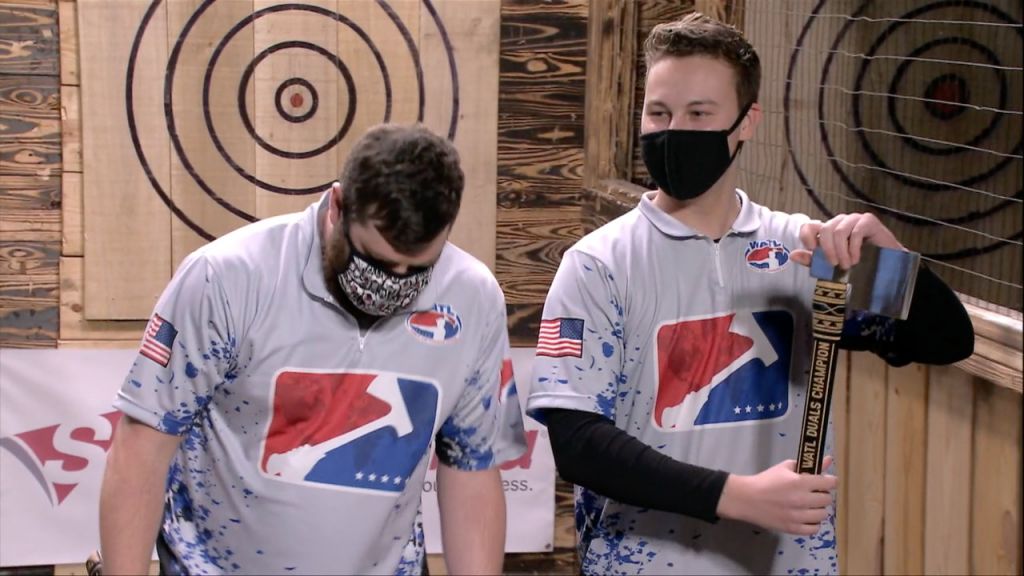
Duals is a partnered competition where two competitors each throw their standard axe (hatchet) simultaneously at the same target from a distance of at least 12 feet from the shared target.
Standard WATL Gameplay, Regular Season, Playoff, and Qualifying rules apply with the exception to the below additions/changes:
- Each team will play 4 games in a sanctioned league night.
- Each game consists of 5 throws per player, per game.
- Duals Killshots:
- Killshots are active for any throw in a game.
- Each team receives 2 Killshots per game.
- Killshots are assigned to a team. Either of the two teammates may take both the Killshots, or they may take one each. Killshots are not limited to 1 per individual.
- Once a Killshot has been hit, throwers are not required to switch Killshots as in Standard Hatchet.
- A third Killshot attempt will not be awarded for any drops during Duals throwing.
- All sanctioned Duals tournaments will consist of a best 2/3 match.
- Venues will have the opportunity to choose a single game, or best 2/3 format for Week 8 tournament matches.
- If there is a fault by either thrower, the team is penalized with a fault and both throwers will receive a zero for that throw.
- A fault occurs when any part of the thrower’s body touches any part of the lane, equipment or building past the fault line, towards the target, before both players’ scores are verbally expressed by the judge.
- A fault occurs if one teammate throws their axe and it hits the target before the other teammate has let go of their axe.
- As a safety precaution players must stand at approximately the same distance for the duration of the throw.
- One player cannot stand at the 12ft line and another at the 15ft line as it introduces a potential risk during the throw
- Players must stand side-by-side with each other, at the same general distance, or if stepping towards the target to throw, their motion must be in general unison
- All axes that stick in the target are awarded points accordingly:
- ie. Team “A” throws their first throw at the same time, one axe lands in the 4 and one axe lands in the 6, giving them a combined score of 10 for that throw
- Once an axe is scored, the presiding Judge may ask the thrower to remove the first scored axe to determine the score of the second axe. If removing the first axe causes the second axe to drop, the lower score threshold will be given.
- For an axe that is embedded into another axe (a Robin Hood), both axes will receive the points of the first axe embedded in the target.
- Sudden Death:
- If there is a tie after 5 throws in a game, the game enters into sudden death.
- ONLY Killshots are allowed during all sudden death throws.
- If all players hit the Killshot, an additional sudden death throw is required.
- Teams will remain in their respective targets for sudden death throws (no switching of targets or Killshots required).
- If all players miss the Killshot during Sudden Death, a measuring tape or accurate measuring device will be used to measure the distance from the closest valid scoring area of each axe head to the closest edge of the Killshot.
- The single axe with the shortest distance on either team will be awarded the game in favor of the team who threw it.
- If one player from each team hits the Killshot and the other players on each team miss, a measuring tape or accurate measuring device will be used to measure the distance from the closest valid scoring area of each axe head, that missed the Killshot, to the closest edge of the Killshot
- The single axe with the shortest distance on either team will be awarded the game in favor of the team who threw it.
- If a player touches their axe before a measurement is made, the game is awarded to the opposing team.
Section O: Sanctioned Duals Leagues
- A WATL Sanctioned Duals League must have a minimum of 2 different teams (4 unique throwers) to be official.
- Each additional league a venue hosts must meet the minimum requirements for throwers.
- Throwers already participating in another sanctioned league at the same venue do not count towards the minimums.
- Marathon leagues are excepted from this rule, and throwers participating in marathon leagues may also count towards a regular league minimum.
- Throwers already participating in another sanctioned league at the same venue do not count towards the minimums.
- Each additional league a venue hosts must meet the minimum requirements for throwers.
- Duals Leagues follow WATL Seasons as outlined in Section K.
Multiple Sanctioned Duals Leagues
- Venues may host more than one Sanctioned Duals League per season.
- Each additional league a venue hosts must include 2 Teams not counting throwers that are participating in another Duals league at the same location (not including Marathon League Throwers).
Duals Marathon Leagues
- Duals Marathon Leagues may be held anytime during a WATL League Season
- A Marathon League is officially sanctioned as long as it meets the following requirement:
- A Marathon League is a league that is held, in its entirety, within 24 hours.
- They must be labeled using the following naming convention: “[Venue Name] [League Night] Marathon League” when creating the League in the WATL app.
- Meets the minimum thrower requirements as outlined in Section K, iv, b
- Players may compete in multiple sanctioned marathon leagues in the same season.
Section P: Qualifying for the Duals
World Championship
Restrictions on Qualifying
- Players can compete for circuit points with multiple duals teams.
- If a player earns a bid to the WATC with multiple teams, the player must notify WATL via [email protected] seven days from the bid announcement to declare their official team that will be receiving the bid. All other teams which the qualified player is a member of will not be eligible for a bid.
- All other teams which the qualified Thrower is a member of will not be eligible for a bid.
- Failure to communicate with WATL regarding official teams will result in a disqualification for all teams in which the player is a member.
- If a player earns a bid to the WATC with multiple teams, the player must notify WATL via [email protected] seven days from the bid announcement to declare their official team that will be receiving the bid. All other teams which the qualified player is a member of will not be eligible for a bid.
- Duals teams may participate in as many sanctioned Duals leagues as they wish, but only one league per season will be considered for circuit points.
- Teams participating in multiple sanctioned events must use the same profile and Team ID to compete in all events.
- WATL is not responsible for Circuit Point issues from using multiple Team IDs
- If a Duals partner cannot attend WATC, the Team will automatically decline their bid.
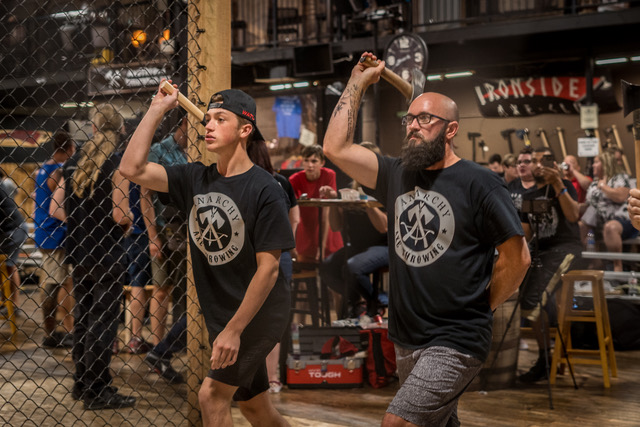
Section Q: WATL Big Axe League
The WATL Big Axe League is a competition where competitors throw a big axe at a target, starting with at least one foot behind the 17ft line, but not ever crossing the 15ft mark. Standard WATL Gameplay, Regular Season, Playoff, & Qualifying rules apply with exception to the below additions/changes:
- Players must start, with one or both feet, behind the 17ft mark
- Players may step over the 17ft mark but may not cross the 15ft mark, otherwise, their throw will be counted as a foot fault and will be scored as a zero
- Players’ feet may not cross the 15ft line until both axes have been verbally scored by the judge. Crossing the 15ft line before the judge scores both axes will result in a foot fault and the player’s throw will be scored a zero.
- If a player calls for a second opinion, both players must return behind the 15ft line until the second judge calls the score.
- If a player touches their axe before a second opinion call is made, the original score given by the first judge stands.
- Throwers will not switch sides during the 5 throw games.
- In a best 2/3 match players will switch sides between games.
- All sanctioned Big Axe tournaments will consist of best 2/3 game sets.
- Venues will have the opportunity to choose a single game, or best 2/3 format for Week 8 tournaments.
- Each player will play 4 games in a sanctioned league night, for a total of 20 big axe throws
- Big Axe Killshots
- Killshots can be called on the 5th throw
- Standard gameplay rules of open Killshots do not apply to Big Axe Throwing
- A WATL Sanctioned Big Axe League must have a minimum of 4 different throwers to be official.
- Each additional league a venue hosts must meet the minimum requirements for throwers.
- Throwers already participating in another sanctioned league at the same venue do not count towards the minimums.
- Marathon leagues are excepted from this rule, and throwers participating in marathon leagues may also count towards a regular league minimum.
- Each additional league a venue hosts must meet the minimum requirements for throwers.
- Big Axe Leagues follow WATL Seasons as outlined in Section K
- Sudden Death Rules
- If there is a tie after 5 throws in a game, the game enters into sudden death.
- ONLY Killshots are allowed during all sudden death throws.
- If all players hit the Killshot, an additional sudden death throw is required and players must throw again for the alternate Killshot.
- Throwers will remain in their respective targets for sudden death throws.
- If all players miss the Killshot during Sudden Death, a measuring tape or accurate measuring device will be used to measure the distance from the closest valid scoring area of each axe head to the closest edge of the Killshot.
- The single axe with the shortest distance on either team will be awarded the game in favor of the team who threw it.
- If measurements are inconclusive, resulting in a tie, players must throw again for the alternate Killshot.
- If a player touches their axe before a measurement is made, the game is awarded to the opposing team.
Multiple Sanctioned Big Axe Leagues
- A WATL Sanctioned Big Axe League must have a minimum of 4 throwers to be official.
- Each additional league a venue hosts must meet the minimum requirements for throwers.
- Throwers already participating in another sanctioned league at the same venue do not count towards the minimums.
- Marathon leagues are excepted from this rule, and throwers participating in marathon leagues may also count towards a regular league minimum.
- Throwers already participating in another sanctioned league at the same venue do not count towards the minimums.
- Each additional league a venue hosts must meet the minimum requirements for throwers.
Big Axe Marathon Leagues
- Big Axe Marathon Leagues may be held anytime during a WATL League Season
- A Marathon League is officially sanctioned as long as it meets the following requirement:
- A Marathon League is a league that is held, in its entirety, within 24 hours.
- They must be labeled using the following naming convention: “[Venue Name] [League Night] Marathon League” when creating the League in the WATL app.
- Meets the minimum thrower requirements as outlined in Section K, iv, b.
- Players may compete in multiple sanctioned marathon leagues in the same season.
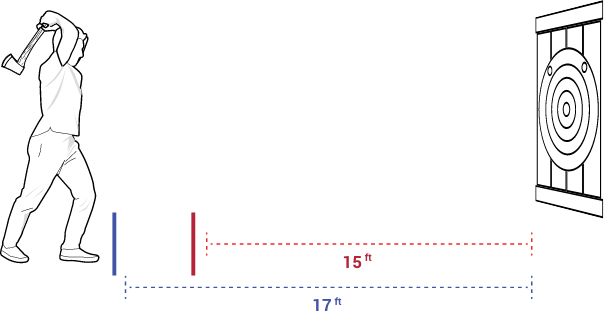
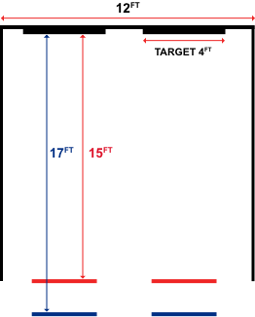
Section R: WATL Big Axe Specs
- The total axe weight must be at least 3.00lbs, but no more than 4.25lbs.
- Big Axe handle length must be a minimum of 23” inches to a maximum of 30” as measured from the lowest point of the handle to the highest point of the eye on top of the axe head.
- The axe blade cannot be more than 4 5/8″
- Double bit axes & Fireman axes are permitted as long as they meet the specifications outlined herein
- Only the forward facing blade will count for scoring purposes
- If there’s an over rotation, and both blades stick to the target, then it will be marked as a fault
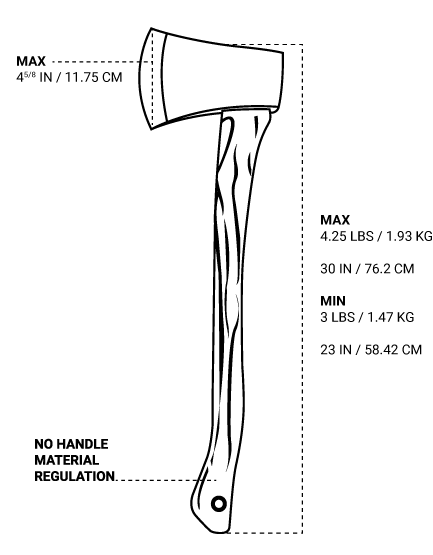
Section S: Qualifying for the Big Axe World Championship
Restrictions on Qualifying
- Throwers may participate in as many sanctioned Big Axe leagues as they wish, but only one league each season will be considered for circuit points.
- Throwers participating in multiple sanctioned Big Axe leagues must use the same profile and Player ID to compete in all leagues.
- Circuit Points will automatically be assigned to the single league that gives the player the most Circuit Points.
- WATL is not responsible for Circuit Point issues from using multiple Player IDs
Section T: WATL Pro League
The World Axe Throwing Professional League (WATL Pro League) is a qualifying system that helps to recognize the top competitors in the sport of axe throwing for standard hatchet competition. Competitors will participate in the WATL Leagues with other players, but will have additional rules and qualifying criteria in place to maintain Pro League status.
- Pros will qualify based on their leaderboard position.
- The top 128 leaderboard finishers (that meet the criteria below) become the next cycle of Pros starting in the next WATL season.
- 2022 Cycle 1 Pros will be ALL 2021 confirmed WATC standard hatchet competitors.
- Criteria to qualify for Pro Status for Cycles 2, 3 and 4 is:
- Must have at LEAST 50% kill shot attempts (28) in their official league.
- A throwers official league is the league chosen automatically in the App to have the highest number of Circuit Points available.
- For example – if a thrower throws in 3 leagues in a single season, the app will choose the league that grants them the most circuit points (based on their total season score in that league) and make that their “official” league. If the thrower did not throw 50% kill attempts in that official league, then ¸they cannot be considered for Pro status in the next cycle.
- Pro Status does not carry forward past the next season.
- For example, if an individual qualifies for Pro Status in Winter League, but does not play a league in the Spring, they do not carry their status to Summer. Throwers have to re-qualify EVERY SEASON for Pro Status.
- Each season, the top 24 Pros (by leaderboard position) will be awarded a WATC Bid
- Pro Bid Winners must have thrown at least 50% kill attempts (28) in their qualifying league.
- Bids trickle down if there are already bid holders in the top 24 finishers
Section U: Venue Cup
By July 31st, WATL will provide an update regarding the Venue Cup.
Still have a rules question?
Send us a message and we'll answer it ASAP!
Get Exclusive Offers & Stay Up-To-Date
Sign-up today and never miss an update in the exciting world of axe throwing.